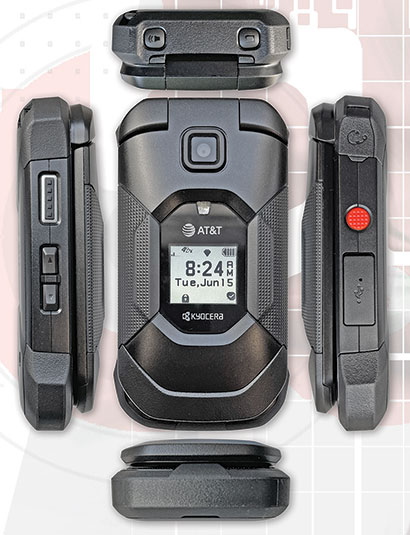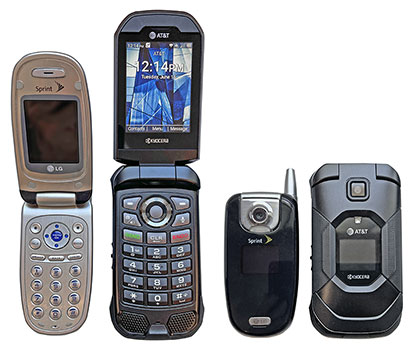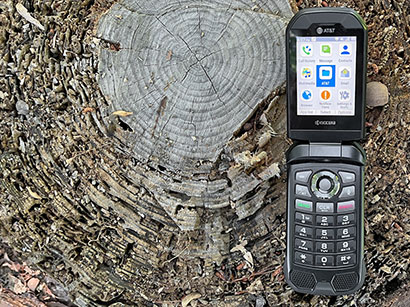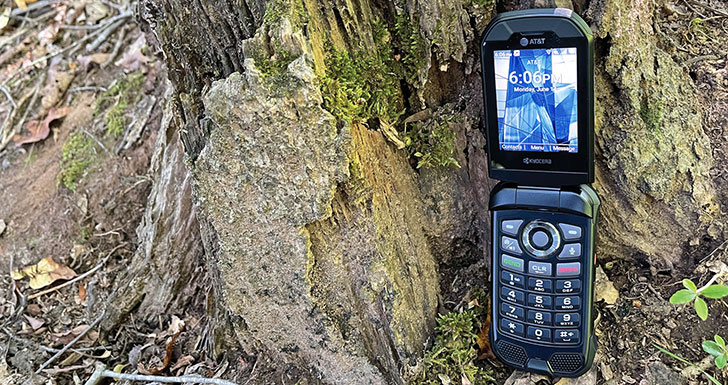|
Kyocera DuraXE Epic
Remember how small and handy flip phones were? Now you can get a tough and rugged and waterproof one from AT&T that's also FirstNet Ready!
(by Conrad H. Blickenstorfer)
There was a time not too terribly long ago when almost all phones were flip phones. Flip phones made perfect sense. They were small and handy. Flip them open and they perfectly fit into your hand. On calls, the speaker was where your ear is, and the microphone in front of your mouth. A great solution. Then the iPhone happened, and nothing was ever the same. But it can be. Flip phones still exist. And with the new DuraXE Epic, Kyocera offers a rugged one — military-grade and FirstNet Ready.

Flip phones, in fact, remain available. They are simply too compelling to completely disappear. The classic flip-open design and concept doesn't scale to the big screens today's complex apps run on, and that's why all modern consumer smartphones pretty much look the same. But if multi-touch and hundreds of complex apps aren't needed, if all that matters is basic, reliable comms functionality, the flip phone remains a very sensible and cost-effective option.
Flip-phones may look retro to today's eyes, but they have a lot to offer. They are small and handy. They have a physical keypad that is quick and easy to use, especially under adverse conditions (gloves, rain, cold, etc.). They have a small external status screen that doesn't require waking up the phone to show all relevant information. They have physical buttons dedicated to important functions. On the DuraXE Epic it's volume up/down and push-to-talk on the left, emergency key on the right, and speakerphone and call list keys on top. On the right is also a modern USB Type-C port plus a real 3.5mm audio jack.

So kudos to Kyocera for still making flip phones, new ones that merge all that was good and great on flip phones with modern tech. And for having done so for years. Kyocera (Kyocera Mobile really; the Kyocera mothership itself has 70,000 employees and makes all sorts of things) is different that way.
Whereas Apple, Samsung and some of the emerging Chinese smartphone makers seek world domination, Kyocera makes phones for those who believe that form should follow function. And functionality for some jobs may mean flip phones, keypad phones, and phones that don't break, phones just like this DuraXE Epic.
In a way, Kyocera's decision is no different from the one Panasonic made when, realizing that laptop computers became generic, concentrated on a niche that became the Toughbook brand. But the two went about it in different ways. Whereas Panasonic established itself as the leader in rugged mobile computing, Kyocera never focussed on a unified brand for its phones and instead primarily moves product through wireless carriers.
The Kyocera DuraXE Epic
But now on to the phone itself. Measuring 4.2 x 2.2 inches, the DuraXE Epic has a small footprint compared to today's smartphones. Its flip design makes it fairly thick, but at about 6.5 ounces it's in the iPhone 12 range weightwise. The DuraXE Epic is small enough to fit almost anywhere though it's actually quite large compared to the diminutive flip phones from back in the day. The picture below shows the DuraXE Epic compared to your typical flip phone from circa 2006.

The DuraXE Epic's screen measures 2.6 inches diagonally and offers the QVGA 240 x 320 pixel resolution that used to be the phone and Pocket PC standard for many years. That translates into 154ppi — sharp enough. There's no touch, so navigation is via an old-style ring and function keys. In some apps there is an arrow icon on the screen that can be moved around via the navigation ring. In a world where everything is capacitive multi-touch, you probably find yourself tapping at the screen while getting used to the DuraXE Epic. But, if you're old enough, after a few minutes you'll remember just how well those flip phones fit into one's hand and how easy it was letting your thumb do all the navigating and operating.
In a way, the DuraXE Epic follows the Volkswagen New Beetle, Mini Cooper and Dodge Challenger school of thought: like those cars, this 2021 flip phone uses retro design, but it's bigger than the original and it uses much improved new technology.
So the DuraXE Epic has a quad-core Qualcomm QM215 chip that's far more powerful than anything those old flip phones had. It also has far more memory (2GB) and storage (16GB) than old flip phones had, and there's also a micro SDXC card slot that can add up to 512GB extra storage.
On the communications side, the DuraXE Epic is lightyears ahead of what was available in the original flip phone era. Our review unit ran on AT&T 4G LTE. It can support a mobile hotspot for up to ten connections, and generally includes all the productivity essentials for public safety, construction, hospitality, and the like. That means push-to-talk (in this case AT&T's EPTT), powerful (100dB+) dual speakers, dual microphone noise cancellation for good audio, and Wireless Priority Service with eMPS (a system that allows avoiding congestion on wireless voice networks) and RTT real-time text support.
The DuraXE Epic is also FirstNet ready. That means first responders and jobs with similar needs can benefit from FirstNet First Priority with always-on priority and preemption for first responders. And if AT&T is not your thing, there's also a Verizon version. That one is called DuraXV Extreme.

As far as battery life goes, Kyocera claims up to 9.5 hours talk time and over 18 days of standby time. Unlike the batteries in almost all consumer phones, the one in the DuraXE Epic is replaceable and easily accessible — just use a coin or screwdriver (or even fingernail) to undo one screw that holds the battery compartment cover in place, remove the cover, and you can pop out the battery and replace it with a freshly charged spare. The small 6.8 watt-hour SCP-73LBPS batteries are inexpensive and readily available. Underneath the battery you'll find the SIM and microSD card slots.
(Not so retro) software
On the software side, the DuraXE Epic looks much like flip phones of yesteryear when phones were feature phones and not yet smartphones. Today, smartphones dominate and they are either iPhones or use the Android OS. What is the DuraXE Epic? The spec sheet says AOSP proprietary. Well, proprietary it may be, but AOSP stands for Android Open Systems Project and that's a no-frills version of Android that doesn't provide access to the Google Play Store and all the popular Google apps.
What that means is that underneath its minimal feature phone interface, the DuraXE Epic is a fully functional, industrial-strength Android 10 phone. All the underpinnings of Android are there, but not Google Maps, Gmail, Drive, Chrome, Photos and all the other Google apps collectively known as "Google Mobile Services." There are, however, more generic version of the essentials: mail, browsing, gallery, camera, utilities, file manager, etc.
The screen captures below show some of the screens and menus on the DuraXE Epic. Android users will quickly see how it all fits together. And yes, you can actually do web browsing on the DuraXE Epic. That's not what this phone is made for and it's cumbersome, but it works. Click on the image compilation to see a full resolution version.

Camera
On the camera side, the problem is that today's smartphones have set a very high bar for picture taking and video. And customers have high expectations of any handheld's image and video quality. The DuraXE Epic does way better than any original flip phone, but it's still marginal by current smartphone standards. There is a 5MP rear camera but no user-facing camera for video calls. 720P video is possible and serviceable, but not great. Could Kyocera have done better even within the flip phone and target cost constraints? Probably.
Click on the image compilation below to see a full resolution version.

As is, still pictures are taken in 1944 x 2592 pixel format, which translates into 5mp shots. There are also "standard resolution" (2mp) and "space saver" (0.1mp) modes. Video can be recorded at 240p, 480p, and 720p. Focus can be continuous or infinity. There is a 5 or 10 second self-timer, and there is a flash. The DuraXE Epic can shoot serviceable images, but this is an area where we'd like to see a next version improved.
Tough and rugged
Now what about ruggedness? That obviously matters. Reliability in harsh conditions is the primary reason why customers will select a device like the DuraXE Epic. Here the news is very good.
There's a very wide operating temperature range, wide enough to use the device pretty much anywhere. There's the IP68 ingress protection rating, which means the phone is totally dustproof and can also handle full immersion down to about six feet for 30 minutes. True, most premium consumer phones also claim to be fully waterproof today but they really don't like water very much, and touch doesn't work when it's wet. With the DuraXE Epic, Kyocera went way beyond just listing IP68 in the specs: we submerged the phone and since it uses buttons to operate, it keeps on working underwater.
There are references to passing various MIL-STD-810H tests: blowing dust & sand/vibration/transit drop from 5 feet, functional shock, alt fog, solar radiation, humidity, temperature extremes, thermal shock, high altitude, icing and freezing rain as well as blowing rain.
And the DuraXE Epic even carries a hazardous locations safety rating. Non-Incendive (no sparking), Class I (flammable gases), Division 2 (present for a short time), Group A-D (types of gases), T4 (max surface temp 275F). For what that means, see Kyocera's brochure.
Kyocera DuraXE Epic: bottom line
The Kyocera DuraXE Epic is a very tough and rugged phone for first responders or anyone else who needs instant, real-time communication in a reliable phone that won't break or quit.
There are two reasons for selecting the Kyocera DuraXE Epic when looking for phone that holds up out there in the field and on the job. One is a fondness for the flip phone design, a form factor that once dominated and even today offers exceptional functionality. The other is that it's a handy, compact, inexpensive and fully rugged phone that doesn't need a case and is virtually invulnerable.
While the DuraXE Epic looks like an old-style feature phone, it's actually based on Android 10 AOSP, so there's plenty of developer expertise and software support. It comes with all the basics needed in the field. It supports memory cards up to 512GB. It's available through AT&T and supports FirstNet. And its list price is just US$269. — Conrad H. Blickenstorfer, June 2021
|


